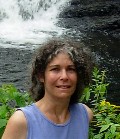Reading Our Region
Essays from a Regional Writer
 Susan Charkes enjoys hearing and telling stories, especially those involving the environment, farming, and sustainability in our region. Discover her poetic view of the outdoors and be inspired to visit the places she describes. Learn more about Susan, her writing, and even hear her podcasts at www.susancharkes.com.
Susan Charkes enjoys hearing and telling stories, especially those involving the environment, farming, and sustainability in our region. Discover her poetic view of the outdoors and be inspired to visit the places she describes. Learn more about Susan, her writing, and even hear her podcasts at www.susancharkes.com.
Sample these selected writings:
| Featured Items: |
Song of the Woods
by Susan Charkes
The song of the veery begins high in the green mist, in the upper reaches of the forest canopy. It enters my consciousness stealthily and without warning, the first few notes soft and deliberate, as if the bird were drilling a small hole in the top of my head and pouring liquid song into it. The notes spiral round and round gathering speed and spinning sound around until the song falls to earth with the mist. It soaks into the ground, and rises with sap in the trees to the bird high in the branches, and when it gets there the song starts again. It sounds of liquid and solid, of up and down, light and dark, cycle and flow, movement and stillness. The trees and the leaves, the water and the soil and the rocks all resonate through it.
The song stops me in my tracks as soon as I hear it, as if the spiraling notes have spun a rope around me and held me in thrall to the singer. I can’t help but look up, to where the song starts, feeling the tall straightness of the trees lead me up just as the guidelines on a flower blossom direct a bee’s attention to the nectar at the center. The veery is the sweet spot at the heart of the forest.
Where oh where is the bird that makes such music? It must be up there but I see nothing, nothing but green leaves. The veery’s woods are deep, and moist, and thick with foliage. The woods are deep on the ground, too, the kind of forest you can’t see through: all the better to provide cover for the veery’s nest near the ground, and for its insect-foraging activities down in the dirt and debris, down where its olive-brown drab merges with dust and detritus, disappearing into duff.
A veery’s home need not be wilderness, but it must be larger than a neighborhood park – at least a “hundred aker wood.” I’ve heard the veery in Bucks County on the forested ridges in and near Nockamixon State Park; in Mercer County on the slopes of Baldpate Mountain, in the Musconetcong Gorge in Hunterdon County, and in the Wissahickon Gorge in Philadelphia.
In all these places, and more, I’ve heard the song begin, closed my eyes, lifted my head, and given myself up to be held by it. In all these places, when the song begins, the world as it is at that moment ends. It ends and then begins anew with this sound like the start of being. The song sung by an invisible singer.
And what good would it do, really, to see the bird sing? Pay no attention to the bird behind the leafy curtain. It’s the song that matters. Not the credit. Why do we feel compelled to know who made the artwork? who painted the picture, or wrote the poem, or composed the music?
When we try and hear the bird, not the song, we lose the music.
Recordings of the veery fall flat. The voice sounds tinny, muffled, one-dimensional. Something is missing.
An iridescent pebble shimmers in a sunny stream. But dried and set on a shelf, it’s dull. Removed from the place that gave its spirit voice through the light charmed by the constantly shifting, flowing energy of water, it turns mute.
Don’t bother digging a lady’s slipper orchid from the woods; it won’t grow elsewhere. Its roots can’t absorb nutrients without the fungi that only live in the soil where that particular orchid grew. The underground filaments are invisible, but the showy flower that depends on them flaunts her bright pink billowy bloom graced with curlicue tendrils. Down below, the fungi toil in secret. She is their song.
The veery’s song excised from the woods is sound, but not music. In the woods, it is not the veery that sings. It is not birdsong that resounds. It is the woods that is the composer. The trees and the leaves, the water and the soil and the rocks, and all that lives above and below. It is the forest itself that sings its own song; the veery is its voice.
© Susan Charkes 2009

